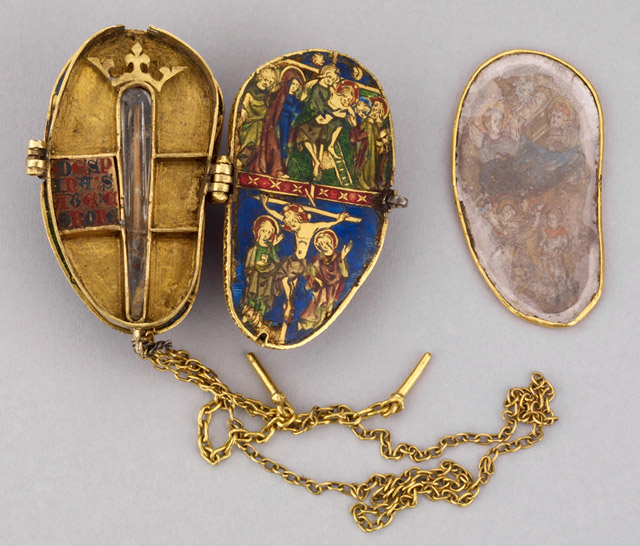Lies about relics
"What lies there are about relics! One claims to have a feather from the wing of the angel Gabriel, and the Bishop of Mainz has a flame from Moses’ burning bush. And how does it happen that eighteen apostles are buried in Germany when Christ had only twelve?"—Martin Luther

by Jennifer Freeman, Art Researcher Christian History magazine
What material objects communicate the presence and reality of God’s grace to you? To some, the honoring of relics might seem like a completely foreign or even superstitious practice, but it is worth considering what objects in our own lives serve as “relics” of the holy—perhaps an old family Bible, a photo, or a belonging of a deceased loved one. For me, one such example of an object communicating grace is my engagement ring. A simple but beautiful piece of jewelry, it once belonged to my sister-in-law, who was tragically killed in a car accident before my husband and I had even started dating. Her widower later gave the ring, which had been in his family, to my husband in a kind of blessing of our relationship.
The term “relic” comes from the Latin reliquum, meaning “remainder.” That is, a relic is a material object which is “left over” from Jesus, Mary, or a saint. Because Jesus ascended to heaven (Acts 1:9-12) and church tradition taught that Mary was “assumed” into heaven, medieval people would have understood them to leave behind no bodily relics (like bones), but only “contact-relics,” that is, material (e.g., cloth) with which they had come into contact. On the eve of the Reformation, the Christianity of Western Europe was characterized by a fervent desire to encounter and tap into divine presence and power. This devotional attitude was so intense and pervasive that it described the vast majority of medieval Europe’s culture: the medieval life was a religious life. Not only that, it was a religious life fueled by “stuff.” This process of intensification had begun in the twelfth century and was fueled by economic and ecclesial growth, as well as the importation of icons from the East due to the crusades.

Image reliquary pendant of the holy thorn, British Museum.
It is difficult, perhaps impossible, to overstate the excessive visual and physical nature of late medieval Christianity, which used images and the material as a central means of accessing the divine. Late medieval religious practice can rightly be generalized as superstitious and “magical,” with its objects of devotion often bearing a close resemblance to volatile pagan deities: for example, some saints were thought to grow angry if their shrines were neglected. The fear caused by the immanence of death (think Black Plague!), the uncertainty of salvation, and the intense desire to secure it led to the increase of relics, public and private images, and devotion to the Eucharist.
At best, the clergy were knowledgeable guides in spiritual matters; at worst, they manipulated and took advantage of a needy and fearful populace. Salvation, the institutional church, material wealth, pilgrimage, the Mass, and visual culture (i.e. religious “stuff”) were all inextricably tangled like the strings of a great, knotted ball of yarn, and the Reformation was their unraveling.
In the quote above, Martin Luther ridicules the unbelievable proliferation and dissemination of relics. Another similar saying is the one that there are enough (alleged) relics of the true cross to build an entire ark! There are two truths bound up in quips such as these. Yes, the distribution of relics was a political and often money-making transaction; relics could build bonds between communities, establish authority, and increase pilgrimage. Not surprisingly, this power led to the fabrication of relics, which is unfortunate, and, as Luther points out, even comical.
But, the second truth wrapped up in such barbs is a spiritual truth about the medieval understanding of the goodness of the material world (as affirmed by God at Creation and the Incarnation) and the power of the spiritual. The multiplication of relics also includes a truth about medieval piety consistent with medieval notions of spiritual power. Miraculous images were even known to reproduce themselves, which, in the medieval mind, was not much different than Jesus’ miracle of the loaves and fishes. In theory, a medieval person would not have been that miffed by a “fake” relic—if it had come into contact with a “true” relic, it was as good as gold, because God is capable of imbuing anything with his holiness.
Of course, relics remain a part of devotional practice for many Christian communities, as they are, for example, still installed in the altars of Catholic and Orthodox churches. But even beyond the traditional conception of a “relic,” it’s useful to reflect on the goodness and power of material creation. Needless to say, the daily presence of the engagement ring on my hand is a reminder of profound loss, but also of the many blessings my husband and I have experienced over the years. Whether you think of them as "relics" or not, take a fresh look at the meaningful objects in your life and let them remind you of grace, of faith, of love from another era.
(Join us each Thursday for a fresh look at a quote from the Reformation era. Sign up via our e-newsletter (in the box at the right) or through our RSS feed (above), or follow us on Facebook for the next year as we celebrate 500 years of Reformation.)
Our film This Changed Everything is a fresh look at the Reformation through the eyes of scholars from a broad range of perspectives.
The latest Christian History magazine is the third in our series on the Reformation. Read it for free here, order it here, and subscribe to get future issues in print here!



